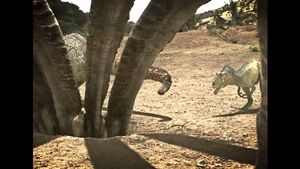
| |
| Creature information | |
| Scientific name : | Lusotitan atalaiensis |
| Time period : | Late Jurassic period |
| Primary diet : | Herbivore |
| In the series | |
| Appearances : | The Watering Hole |
Lusotitan was a Brachiosauridae sauropod that appeared in The Watering Hole, the 2nd episode of Dinosaur Revolution. A herd of them drank the remaining drinking water left and leave with other dinosaurs like Dinheirosaurus and Miragaia follow them.
Physical Characteristics
It has been estimated that Lusotitan was 25 meters (82 feet) long. It had long forearms, one of the reasons Mateus assigned it to the Brachiosauridae. What bones are known indicate that Lusotitan was a brachiosaurid sauropod, and even though the skull is not known it is a reasonable proposition that it was similar to the skulls of other members of the this group. Recent studies then showed it was possibly a basal macronarian and not a brachiosaurid.
Discovery
In 1947 Manuel de Matos, a member of the Geological Survey of Portugal, discovered large sauropod fossils in the Portuguese Lourinhã Formation that date back to the Tithonian stage of the Late Jurassic period.In 1957 Albert-Félix de Lapparent and Georges Zbyszewskinamed the remains as a new species of Brachiosaurus: Brachiosaurus atalaiensis. The specific name referred to the site Atalaia. In 2003 Octávio Mateus and Miguel Telles Antunes renamed a separate genus: Lusotitan. The type species is Lusotitan atalaiensis. The generic name is derived from Luso, the Latin name for an inhabitant of Lusitania, and from the Greek word "Titan", a mythological giant.
The finds consisted of a partial skeleton lacking the skull and individual vertebrae uncovered in several locations. De Lapparent did not assign a holotype. In 2003 Mateus chose the skeleton as the lectotype. Its bones have the inventory numbers MIGM 4798, 4801-10, 4938, 4944, 4950, 4952, 4958, 4964-6, 4981-2, 4985, 8807, and 8793-5. These remains include 28 vertebrae and elements of the appendicular skeleton.
Trivia
Lusotitan is not the only dinosaur once thought to be restricted to North America to be later discovered in Portugal. Remains of Stegosaurus have also been found in Portugal which further reinforces the idea that there was a land bridge connection between Western Europe and North America back towards the end of the Jurassic period.
Lusotitan's remains have no known skull, and a skull is yet to be found.
Lusotitan was thought to originally be a species of Brachiosaurus
